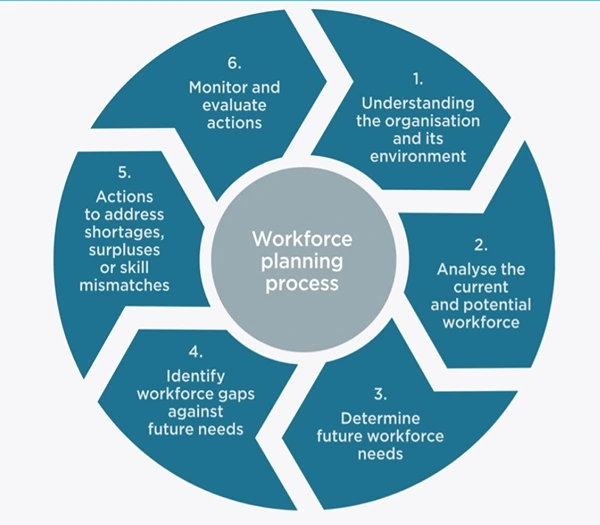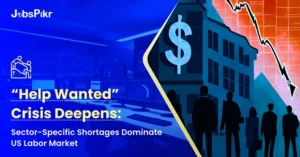The intersection of HR analytics and enterprise agility is intertwined with economic flux, shifting business models, hybrid work scenarios, and changing employee attitudes. In modern times, agility isn’t just a buzzword; it’s an imperative an enterprise must master. To remain agile, an enterprise must quickly respond to disruptions, scale teams up or down, and ensure proper talent alignment—all made possible through HR workforce analytics.
Traditionally, HR exited the core business ‘value-based’ processes as a support-intensive function focusing on compliance, headcount, and simple reporting. Today, however, organizations expect far more from their HR. They want strategic foresight – what will be the demand in terms of skills in the subsequent year? Which teams face attrition? How do we downsize without negatively impacting productivity?
This shift is capable of answering by improved data and use of that data. This is the realm of workflow planning and analytics. By moving away from looking into the past through reports and embracing forecasting with real-time data, HR leaders can help drive business agility.
We will look at how businesses use HR workforce analytics to propel their agile workforce strategies through headcount forecasting, attrition modeling, dynamic scenario planning, and resource optimization. In addition, observe how JobsPikr’s platforms allow HR teams to tailor their plans with business objectives through external insights into the labor market and preemptively react to shifts.
What is HR Workforce Analytics? Defining the Foundation for Smarter Planning
HR workforce analytics incorporate both historical and predictive data to evaluate, strategize and optimize a company’s workforce. It is not just reporting the headcount or turnover figures, but instead allows HR teams to make decisions based on patterns, forecasts, business needs and more.
Fundamentally, workforce analytics addresses important issues like:
- What skill capabilities are currently absent and which ones will be needed in the future?
- Which business units are forecasted to experience a talent surplus?
- Which areas or roles do we have an overabundance of staff?
- How can we improve the alignment of our hiring processes with the anticipated growth of the business?
Traditional HR reporting focuses on the past, while HR workforce planning powered by analytics emphasizes the future. It enables organizations to shift from reactive hiring to proactive workforce planning. For instance, analytics can predict staffing shortages months before product launch timelines. This foresight provides HR departments the opportunity to strategically source, train, or redeploy talent.
Workforce analytics also integrates data from outside the organization, including performance, attrition, training metrics, and labor market data. These elements combine to portray the overall condition of a workforce, its competitive stance, and its readiness for the future. JobsPikr, for example, provides that external context by monitoring regional and industry job demand, skill availability, and salary benchmarks.
In summary, HR workforce analytics empowers people leaders to make timelier, better-informed, and more coordinated decisions, thereby enhancing flexibility and responsiveness from within the organization.

How HR Workforce Analytics Enables Better Workforce Planning and Management
In order for enterprises to remain agile, they need to not only understand who is in their workforce today, but who they will require in the future. This is precisely where HR workforce analytics transform paradigms. It provides order to planning and enables HR executives to sync the workforce strategy with the business objectives.
Aligning Workforce Supply with Business Demand
One of the most critical problems of HR workforce planning is pacing the talent supply to keep up with the growth of the business. Whether it involves entering a new market, launching a product, or even expanding a service line, the need for talent shifts rapidly. A skilled workforce analytics team can predict such needs well in advance. They can determine them by analyzing historical hiring data, timelines for potential projects, and geophysical trends in available labor.
Instead of the HR scrambling to hire on short notice, HR teams can build the necessary talent pipelines proactively and make certain the required talent in place when needed.
Forecasting Talent Needs and Attrition
With the aid of predictive analytics, patterns associated with attrition can be revealing mysteries assisting HR personnel in recognizing when and where apportionment of talent is likely to be gaps. For instance, data revealing mid-level managers within certain regions tend to exit after two years indicates a need for HR to intervene with tailored engagement strategies or implement early succession planning.
Instead of waiting and reacting, enterprises could anticipate gaps to mitigate disruption and safeguard institutional knowledge.

Supporting Agile, Data-Driven Decisions
In fast-paced settings, static headcount forecasts often miss the mark. Human Resources’ (HR) strategic planners need to validate hypotheses, devise multiple workforce scenarios, and have the ability to pivot. With workforce planning and analytics, teams are able to model simulations of hiring freezes, growth surges, or role eliminations and visualize their downstream operational, cost, and scheduling impacts.
Such agility is only possible when HR deals with real time predictive insights as opposed to historical reporting.
External data enhances internal data through trends in job demand and skill availability per region. Data platforms like JobsPikr improve this process because they ensure that workforce planning incorporates not only internal demands and requirements, but external labor market conditions.
Optimizing Headcount and Scenario Planning Through Analytics

The arbitrarily defined static headcount also quickly conflicts with today’s dynamic business environment. Evolving business needs, budget shifts, and changing priorities make maintaining preset plans untenable. To counter this reality, a growing number of organizations have begun employing HR workforce analytics to introduce agility and accuracy into headcount and scenario modeling.
Smarter Headcount Optimization
HR Analytics permits teams to move beyond a blanket approach of hiring and layoffs towards data-driven evaluations based on role, geography, function, or cost-center for informed strategic decisions.
An example would be an enterprise that, based on an analytics review, discovers that some low impact roles are overstaffed in one region while some other teams are critically short on skilled contributors. While budget strains may compel the enterprise to cut spends, HR leaders can instead remove broad cuts by rebalancing the workforce which minimizes disruption and maximizes productivity.
Insight-driven headcount optimization helps balance workforce capacity and demand to avoid overhiring, which affects costs and lowers efficiency. Teams are leaner with demand, while burnout and bottlenecks are risks that HR manages to avoid.
Scenario Planning for Agility
What if the revenue projections are shifted for the upcoming quarter? What if a product launch gets delayed? How does hiring freeze impact project delivery?
Simulating these “what-if” scenarios is now possible for HR leaders through workforce analytics. Such aids offer predictive modeling of business outcomes in the context of pre-set workforce devising business decisions such as role eliminations, team expansions, or location shifts.
As a result, enterprise wide workforce planning gets more comprehensive but also is fully aligned with finance, operations and even the executive reliant on HR for strategic direction.
Equipped with external data on labor markets, in real-time, as provided by JobsPikr, HR can incorporate trends, for example, salary shifts or hiring surges within specific regions into scenario planning for agile business response
Leveraging HR Workforce Planning to Impact Business Outcomes
Responsiveness within the workforce is not only a matter of speed, but also requires precise timing coupled with the right data to drive decisions. Relating this to 2025 and beyond, the implication is that intuition-based frameworks and static reports of the past will need to be replaced with fundamental tools for strategy execution, such as HR workforce analytics.
The use of predictive models and real-time data are enabling HR departments to shift from a reactive business support role to one that drives the business forward. Talent strategy alignment with organizational growth, confident headcount planning, and the ability to help organizations respond to change seamlessly are now possible.
Agile action in areas like forecasting attrition, optimizing hiring plans, and testing various workforce scenarios is made possible through the use of analytics in HR workforce planning.
Platforms like JobsPikr enhance this capability by integrating external labor market signals—such as job demand trends, salary benchmarks, and talent availability by region—into the planning process. This gives HR leaders a more complete, contextual view of both internal workforce dynamics and external market realities.
Ready to transform your HR strategy with predictive workforce insights?
Explore JobsPikr and empower your HR team to lead with data, not assumptions.



